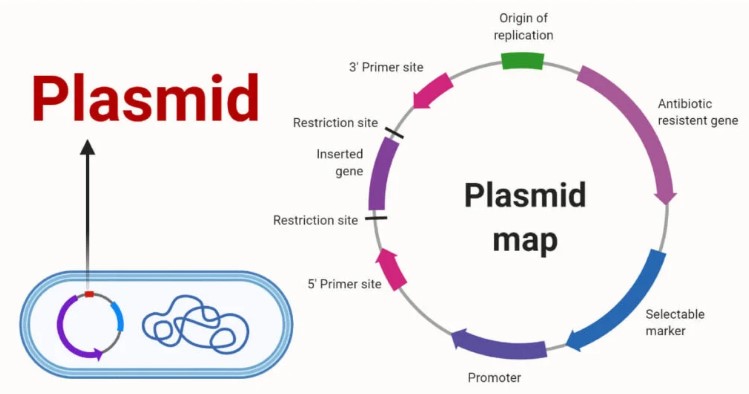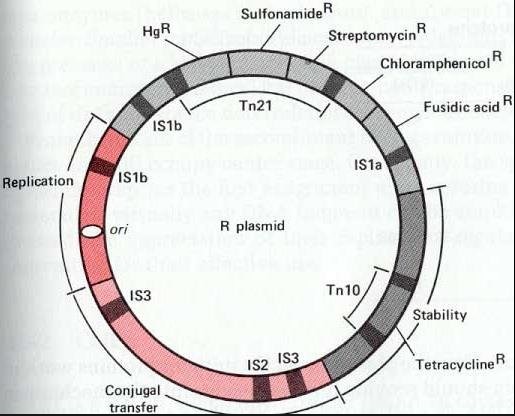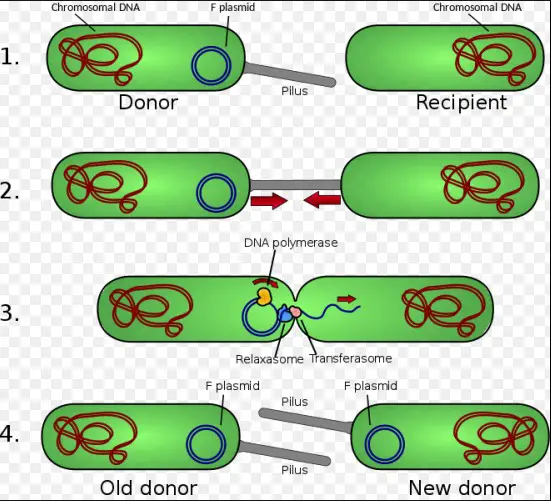Plasmids are circular, double-stranded DNA molecules found in bacterial cells, distinct and separate from their chromosomal DNA. These genetic elements play a crucial role in bacteria’s ability to adapt and evolve by facilitating the transfer of genetic information. Among the diverse types of plasmids, F plasmids and R plasmids stand out due to their unique functions and impacts on bacterial behavior.
The primary difference between F plasmids and R plasmids lies in their roles and genetic makeup. F plasmids are responsible for bacterial conjugation, a process of genetic transfer between bacteria, enhancing genetic diversity and adaptation. On the other hand, R plasmids confer antibiotic resistance to bacteria, a pressing concern in medical and environmental microbiology due to its role in the spread of antibiotic-resistant infections.
Focusing on these plasmids sheds light on the mechanisms behind bacterial conjugation and antibiotic resistance. F plasmids facilitate the direct transfer of genes between bacteria, whereas R plasmids carry genes that help bacteria withstand the effects of antibiotics. Understanding these plasmids not only provides insights into bacterial evolution but also aids in the development of strategies to combat antibiotic resistance, a growing threat to public health worldwide.

Plasmid Basics
What Are Plasmids?
Definition and Function
Plasmids are small, circular pieces of DNA that exist independently from a bacterial cell’s main chromosome. Unlike the main genomic DNA, plasmids can replicate on their own. They are considered nature’s way of enabling genetic diversity and adaptability among bacterial populations. Plasmids often carry genes that can provide critical survival advantages to bacteria, such as resistance to antibiotics or the ability to metabolize unusual substances.
Role in Bacterial Adaptation and Evolution
Plasmids play a pivotal role in the evolution and adaptation of bacterial species. By transferring genes among different bacteria, they facilitate rapid genetic changes that can help a population withstand environmental stresses, such as exposure to antibiotics. This process not only aids in the survival of bacteria in adverse conditions but also in the evolution of new traits that can be beneficial in their changing environments.
Types of Plasmids
Overview of Different Plasmid Types
There are several types of plasmids, each classified based on the function of the genes they carry. Some common types include:
- Fertility plasmids (F plasmids), which enable bacteria to transfer genetic material to one another.
- Resistance plasmids (R plasmids), which provide bacteria with the ability to resist antibiotics.
- Virulence plasmids, which give bacteria the genes they need to become pathogenic.
- Degradative plasmids, which enable the digestion of unusual substances.
Introduction to F and R Plasmids
Among these, F plasmids and R plasmids are particularly noteworthy due to their significant roles in bacterial genetics and their implications for human health. F plasmids are key players in bacterial conjugation, a process that allows bacteria to share genetic information, increasing genetic diversity. R plasmids, on the other hand, are central to the development of antibiotic resistance, a growing concern in the treatment of bacterial infections.
F Plasmid Explained
Definition and Characteristics
Detailed Description of F Plasmid
The F plasmid, also known as the fertility or sex plasmid, contains genes that enable a bacterial cell to produce a pilus. The pilus is a hair-like appendage that attaches to another bacterial cell, facilitating the transfer of genetic material. This ability makes F-plasmid-carrying bacteria donors in the process of conjugation.
Key Features and Functions
Some key features of F plasmids include:
- Initiation of conjugation: The presence of an F plasmid enables a bacterial cell to initiate the conjugation process.
- Transfer of genetic material: F plasmids can carry additional genes that may be transferred along with the plasmid DNA, leading to the spread of beneficial traits among bacterial populations.
Role in Conjugation
Mechanism of Bacterial Conjugation
Bacterial conjugation involves the following steps:
- A donor cell with an F plasmid extends a pilus to make contact with a recipient cell.
- The pilus retracts, bringing the two cells into close contact.
- The F plasmid is replicated, and a copy is transferred to the recipient cell through a mating bridge.
F Plasmid’s Involvement in Gene Transfer
This process not only spreads the F plasmid itself but can also facilitate the transfer of other genetic elements between cells, contributing to genetic diversity and adaptability in bacterial populations.
R Plasmid Explained
Definition and Characteristics
Detailed Description of R Plasmid
R plasmids are genetic elements that provide bacteria with the ability to resist the effects of antibiotics. They carry genes that encode resistance factors for one or more antibiotics, making their hosts difficult to eliminate with standard treatments.
Key Features and Functions
Key aspects of R plasmids include:
- Resistance to antibiotics: By carrying genes that confer resistance to antibiotics, R plasmids play a critical role in the spread of antibiotic-resistant bacteria.
- Transferability: Like F plasmids, R plasmids can be transferred between bacteria, spreading resistance genes across different species and strains.
Role in Antibiotic Resistance
Mechanism of Antibiotic Resistance
The genes carried by R plasmids can encode for a variety of mechanisms that render antibiotics ineffective, including:
- Production of enzymes that degrade or modify antibiotics.
- Alteration of target molecules within the bacteria, so the antibiotic can’t bind to them.
- Efflux pumps that remove antibiotics from the bacterial cell before they can take effect.
R Plasmid’s Contribution to Resistance Spread
The ability of R plasmids to move from one bacterium to another via conjugation means that resistance traits can rapidly spread through bacterial populations, complicating the treatment of infectious diseases and leading to the emergence of multi-drug-resistant bacterial strains.

Key Differences
Genetic Composition
Comparison of Genetic Structures
The genetic structures of F and R plasmids differ significantly, primarily due to the types of genes they carry. F plasmids are characterized by their fertility genes, which enable bacterial conjugation. These genes code for the formation of the sex pilus and the transfer apparatus required for DNA transfer between cells. In contrast, R plasmids contain resistance genes that provide bacteria with the ability to withstand antibiotics. These resistance genes can vary widely, offering protection against a range of antibiotics.
Unique Genes in F and R Plasmids
F plasmids uniquely house a set of genes essential for initiating and completing the process of conjugation. These include the tra (transfer) genes responsible for pilus formation and the relaxase enzyme necessary for plasmid transfer.
R plasmids, however, carry genes that code for antibiotic-deactivating enzymes, modification of antibiotic targets within the bacterium, and efflux pumps that expel antibiotics from the cell. The specific genes present can differ greatly among R plasmids, reflecting the variety of antibiotics they provide resistance to.
Functional Differences
Distinct Roles in Bacterial Processes
F and R plasmids play distinct roles in bacterial physiology and survival strategies. F plasmids are pivotal in genetic exchange and diversity, enabling bacteria to share and acquire new genetic information through conjugation. This process can enhance bacterial adaptation to environmental stresses and contribute to the evolution of new traits.
R plasmids, on the other hand, are central to the development and spread of antibiotic resistance. They allow bacteria to survive in environments where antibiotics are present, such as in clinical settings or within the bodies of treated hosts.
Impact on Bacterial Capabilities
The presence of F plasmids can significantly increase a bacterial population’s genetic diversity, thus enhancing its adaptability and survival in changing environments. Conversely, R plasmids directly impact a bacterium’s ability to withstand pharmaceutical interventions, leading to treatment failures and the spread of resistant infections.
Significance in Research
F Plasmid Studies
Insights Gained from F Plasmid Research
Research on F plasmids has provided invaluable insights into the mechanisms of bacterial conjugation, gene transfer, and genetic diversity. Understanding how F plasmids facilitate DNA transfer between bacteria has shed light on bacterial evolution, the spread of beneficial traits, and the mechanisms underlying bacterial adaptation to new niches.
Applications in Genetic Engineering
The knowledge gained from F plasmid studies has been instrumental in developing genetic engineering techniques. Scientists now utilize F plasmids to introduce new genes into bacteria, enabling the production of pharmaceuticals, the degradation of pollutants, and the synthesis of valuable biochemicals. F plasmids have become tools in biotechnology for creating genetically modified organisms (GMOs) with desired traits.
R Plasmid Studies
Insights Gained from R Plasmid Research
The study of R plasmids has been crucial in understanding the molecular basis of antibiotic resistance. Researchers have identified the specific genes responsible for resistance to various antibiotics, how these genes are transferred between bacteria, and the evolutionary pressures that drive the spread of resistance.
Impact on Antibiotic Resistance Understanding
This research has significantly impacted our approach to treating bacterial infections, guiding the development of new antibiotics that can circumvent resistance mechanisms and informing strategies to limit the spread of resistant bacteria.
Environmental and Health Implications
Spread of Resistance
How R Plasmids Contribute to Antibiotic Resistance Proliferation
R plasmids facilitate the rapid spread of antibiotic resistance among bacterial populations, not just within a species but across different species and genera. This ability dramatically complicates efforts to control infectious diseases and necessitates ongoing research into new antimicrobial strategies.
Environmental Factors Affecting Spread
Various environmental factors, such as the overuse of antibiotics in agriculture and healthcare, contribute to the proliferation of R plasmids. These practices select for bacteria harboring resistance genes, leading to an increased frequency of resistance in the environment and posing a significant challenge to public health.
Biotechnological Applications
Utilizing F Plasmids in Gene Editing
F plasmids have found applications beyond traditional genetic engineering, particularly in the burgeoning field of gene editing. Scientists harness the natural gene transfer capabilities of F plasmids to introduce specific genetic modifications into target organisms, offering promising avenues for medical research, agriculture, and environmental biotechnology.
Potential Future Applications
The continued study of F and R plasmids holds the potential to revolutionize our approach to numerous challenges. From developing new treatments for antibiotic-resistant infections to creating more sustainable biotechnological processes, the insights gained from these plasmids are paving the way for innovations that could have a profound impact on our world.

Frequently Asked Questions
What are plasmids?
Plasmids are small, circular DNA molecules that exist independently of the chromosomal DNA in bacteria. They are capable of replicating independently and play a vital role in genetic variation and adaptation by carrying genes beneficial for survival, such as those for antibiotic resistance or virulence factors.
How do F plasmids facilitate bacterial conjugation?
F plasmids contain genes that enable bacteria to form a physical connection with other bacteria and transfer genetic material. This process, known as conjugation, allows for the direct transfer of the F plasmid and any other genetic elements it may carry, promoting genetic diversity and adaptation among bacterial populations.
Why are R plasmids a concern in medical microbiology?
R plasmids are a significant concern because they carry genes that confer resistance to antibiotics. This enables bacteria to survive and proliferate even in the presence of antibiotic treatments, leading to the spread of antibiotic-resistant infections. Understanding and controlling the spread of R plasmids is crucial in combating antibiotic resistance.
Conclusion
The exploration of F and R plasmids illuminates the intricate ways in which bacteria adapt and survive in various environments. By understanding the mechanisms of genetic transfer facilitated by F plasmids and the defense against antibiotics provided by R plasmids, researchers can develop more effective strategies to address antibiotic resistance, one of the most pressing health challenges of our time.
The significance of these plasmids extends beyond bacterial genetics; it touches upon the broader implications for public health and the environment. As we continue to uncover the complexities of F and R plasmids, we pave the way for innovations in medical treatment and biotechnology, highlighting the importance of genetic research in the ongoing battle against antibiotic-resistant bacteria.

